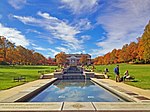Robert H. Smith School of Business
1921 establishments in MarylandBusiness schools in MarylandUniversities and colleges established in 1921University of Maryland, College Park facilitiesUniversity subdivisions in Maryland
The Robert H. Smith School of Business (Smith School) is the business school at the University of Maryland, College Park, a public research university in College Park, Maryland. The school was named after alumnus Robert H. Smith (Accounting '50). One of 12 colleges and schools at the university's main campus, the Smith School offers programs at both the graduate and undergraduate levels. It is accredited by the Association to Advance Collegiate Schools of Business (AACSB) to award bachelor's, master's, and doctoral degrees in business.
Excerpt from the Wikipedia article Robert H. Smith School of Business (License: CC BY-SA 3.0, Authors).Robert H. Smith School of Business
50th Place, College Park Daniels Park
Geographical coordinates (GPS) Address Website Nearby Places Show on map
Geographical coordinates (GPS)
| Latitude | Longitude |
|---|---|
| N 38.9875 ° | E -76.94 ° |
Address
University of Maryland, College Park (UMD)
50th Place
20742 College Park, Daniels Park
Maryland, United States
Open on Google Maps







